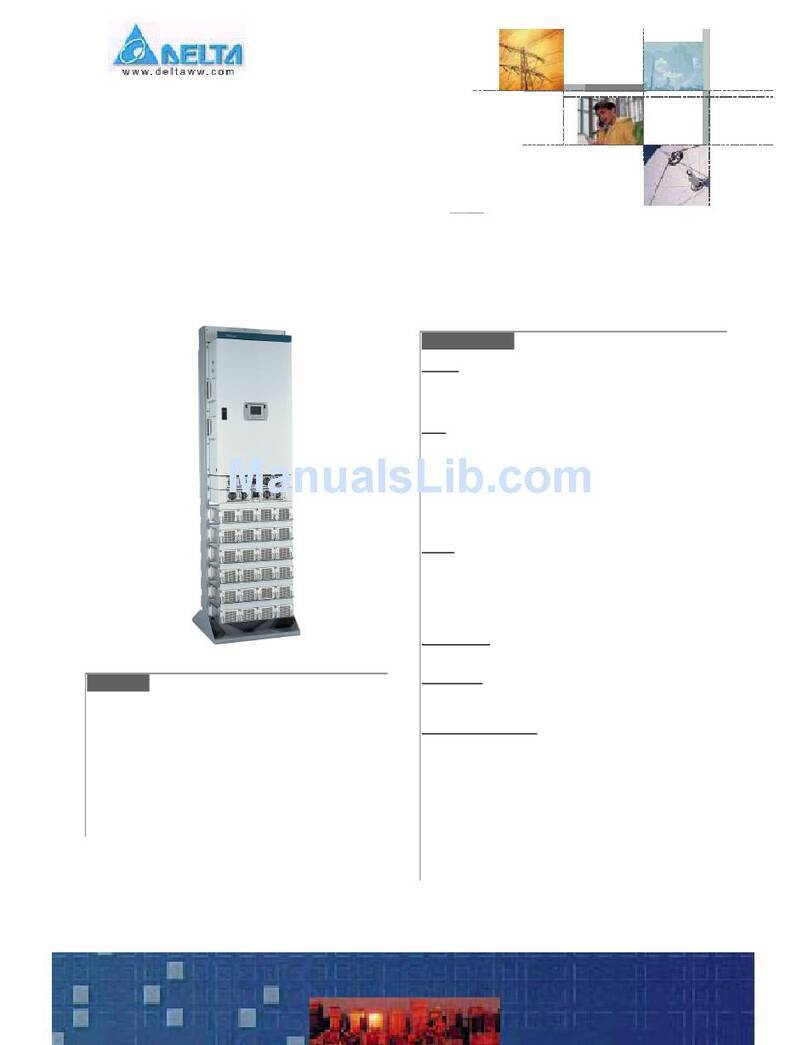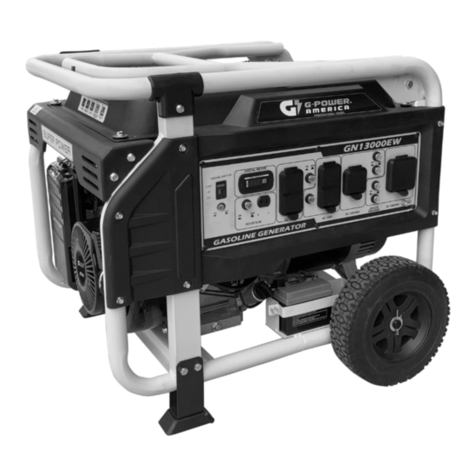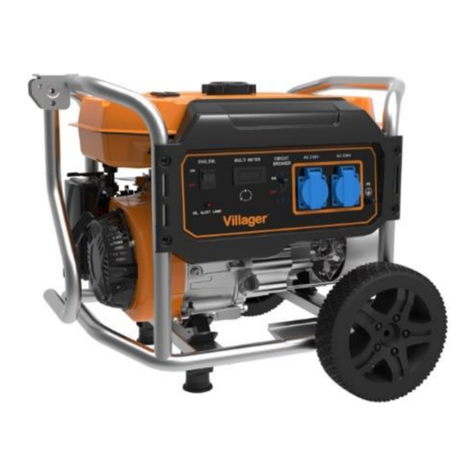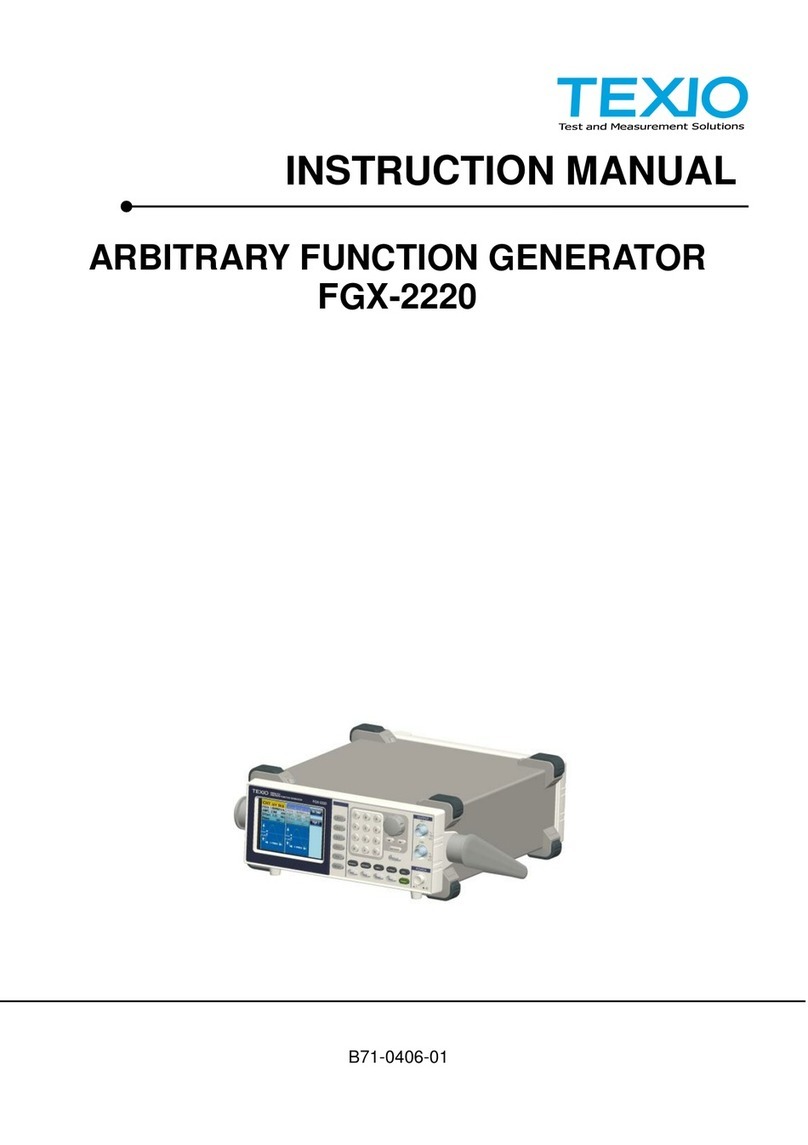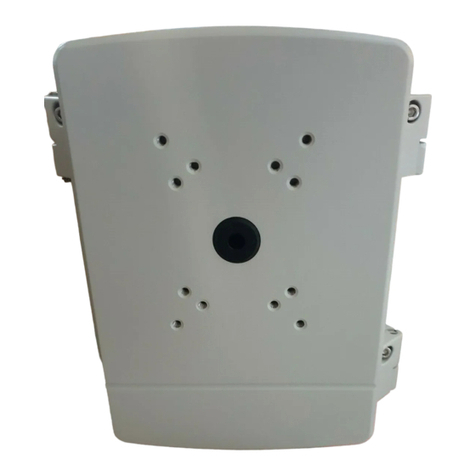RocwooD RWPG1E User manual

RocwooD
Instruction Manual
NOTE: PLEASE READ INSTRUCTIONS CAREFULLY BEFORE USE.
POWER
GENERATOR

INTRODUCTION
DANGER
DANGER DANGER
WARNING
WARNING
[CAUTION]
Indicates a possibility of death or serious injury if instructions are not followed.
Indicates a strong possibility of severe personal injury, loss of life and equipment damage if instructions
are not followed.
• The generator is designed to give safe and dependable service if operated according to instructions.
• Do not operate the generator before you have read and understood the instructions. Failure to do so
could result in death, personal injury or equipment damage.
Indicates a possibility of personal injury or equipment damage if instructions are not followed.
Using a generator indoors CAN KILL YOU IN MINUTES.
Generator exhaust contains carbon monoxide. This is a
poison you cannot see or smell.
Never let spilt fuel REACH HOT PART of Generator.
NEVER use inside a home
or garage, EVEN IF doors
and windows are open.
Only use OUTSIDE and
far away from windows,
doors, and vents.
NOTE :
Gives helpful information.
If a problem should arise, or if you have any questions about the generator, consult an authorized dealer
or service shop

SAFETY INSTRUCTIONS
WARNING
WARNING
WARNING
WARNING
WARNING
WARNING
WARNING
Please make sure you review each precaution carefully.
Do not operate the generator near fuel because of the potential danger of explosion or re. Do not ll
the fuel tank with fuel while the engine is running. Do not smoke or use naked ame near the fuel tank.
Be careful not to spill fuel during refueling. If fuel is spilt, wipe it o and let dry before starting the engine.
Do not place ammables near the generator.
Be careful not to place fuel, matches, gunpowder, oily cloths, straw, trash, or any other in ammables
near the generator.
Do not enclose the generator nor cover it with a box. The generator has a built-in forced air cooling
system, and may become overheated if it is enclosed. If generator has been covered to protect it from the
weather during non use, be sure to remove it and keep it well away from the area during generator use.
Operate the generator on a level surface.
It is not necessary to prepare a special foundation for the generator. However, the generator will vibrate
on an irregular surface, so choose a level place without surface irregularities. If the generator is tilted
or moved during operation, fuel may spill and / or the generator may tip over, causing a hazardous
situation. Proper lubrication cannot be expected if the generator is operated on a steep incline or slope.
In such a case, piston seizure may occur even if the oil is above the upper level.
Pay attention to the wiring or extension cables from the generator to the connected device. If the wire is
under the generator or in contact with a vibrating part, it may break and possibly cause a re, generator
burnout, or electric shock hazard. Replace damaged or worn cables immediately.
Do not operate in rain, in wet or damp conditions, or with wet hands. The operator may suer severe
electric shock if the generator is wet due to rain or snow.
Do not operate the generator inside a room, cave, tunnel, or other insuciently ventilated area.
Always operate it in a well-ventilated area, otherwise the engine may become overheated, and the
poisonous carbon monoxide gas an odorless, colorless, poison gas, contained in the exhaust gas will
endanger human lives. Operate generator only outdoors and far from open windows, doors,
ventilation intakes and other openings. Keep the generator at least 1 metre (3 feet) away , including
overhead, from any structure or building use.

WARNING
WARNING
WARNING
WARNING
WARNING
WARNING
WARNING
WARNING
WARNING
WARNING
If wet, wipe and dry it well before starting. Do not pour water directly over the generator, nor wash it
with water.
Be extremely careful that all necessary electrical grounding procedures are followed during each and
every use. Failure to do so can be fatal.
Do not contact the generator to a commercial power line. Connection to a commercial power line
may short circuit the generator and ruin it or cause electric shock hazard. Use the transfer switch for
connecting to domestic circuit.
No smoking while handling the battery. The battery emits ammable hydrogen gas, which can explode
if exposed to electric arcing or naked ame. Keep the area well-ventilated and keep naked ames/sparks
away when handling the battery.
Engine becomes extremely hot during and for some time after operation. Keep combustible materials
well away from generator area. Be very careful not to touch any parts of the hot engine especially the
muer area or serious burns may result.
Keep children and all bystanders at a safe distance from work areas.
It is absolutely essential that you know the safe and proper use of the power tool or appliance that you
intend to use. All operators must read, understand and follow the tool/appliance owners manual. Tool
and appliance applications and limitations must be understood. Follow all directions given on labels and
warnings. Keep all instruction manuals and literature in a safe place for future reference.
Use only “LISTED” extension cables. When a tool or appliance is used outdoors, use only extension
cables marked “For Outdoor Use”. Extension cables, when not in use should be stored in a dry and well
ventilated area
Always switch o generator’s AC circuit breaker and disconnect tools or appliances when not in use,
before servicing, adjusting, or installing accessories and attachments.
Make sure the engine is stopped before starting any maintenance, servicing or repair. Make sure
maintenance and repair of the generator set are performed by properly trained personnel only.
SAFETY INSTRUCTIONS

Specications are subject to change without notice.
SPECIFICATIONS
Maximum Output: 2800W/2.8kW/3.4KVA
Voltage Regulator: Automatic voltage regulator
Emergency Indicator: Auto breaker overload protection
Safety Measures: Low oil automatic shut down
Continuous Rated Output: 2600W/2.6kW
Rated Voltage: 220V
Fuel Tank Capacity: 11 Litres
Oil Capacity: 0.6L
Oil Type: 10W30 or 10W40
Engine Type: Single-Cylinder, 4-Stroke, Air-Cooled, OHV horizontal shaft
Engine Output: 8hp
Engine displacement: 210cc
Starting System: Electric
Continuous Operating Time: 10h
Noise Level: 66dB
RocwooD Electric Start Model: RWPG1E
RocwooD Recoil Start Model: RWPG1
Maximum Output: 2800W/2.8kW/3.4KVA
Voltage Regulator: Automatic voltage regulator
Emergency Indicator: Auto breaker overload protection
Safety Measures: Low oil automatic shut down
Continuous Rated Output: 2600W/2.6kW
Nominal Current: 12.7A
Rated Voltage: 220V
Fuel Tank Capacity: 11 Litres
Oil Capacity: 0.6L
Oil Type: 10W30 or 10W40
Engine Type: Single-Cylinder, 4-Stroke, Air-Cooled, OHV horizontal shaft
Engine Output: 8hp
Engine displacement: 210cc
Starting System: Recoil
Continuous Operating Time: 10h
Noise Level: 66dB

COMPONENTS
1. Fuel tank
2. Fuel valve
3. Air filter cover
4. Choke lever
5. Engine switch
6. Oil filler plug
7. Recoil starter handle
8. AC sockets
9. Volt
10. AC circuit breaker
11. DC circuit breaker
12. DC output
1
2
3
4
56
7
8
11 12
9
10

PRE OPERATION CHECKS
CHECK ENGINE OIL
RECOMMENDED ENGINE OIL :
Before checking or relling oil, be sure generator is located on
stable and level surface with engine stopped.
• Remove oil ller cap and check the engine oil level.
• If oil level is below the lower level line, rell with suitable
oil (see table) to upper level line. Do not screw in the
oil ller cap when checking oil level.
• Change oil if contaminated. (See “How-To” Maintenance.)
Use 4-stroke automotive detergent oil of API service class SE or higher grade (SG, SH or SJ is
recommended). SAE 10W-30 or 10W-40 is recommended for general, all-temperature use. If single
viscosity oil is used, select the appropriate viscosity for the average temperature in your area
Oil capacity (Upper level) : 0.6L / 0.15Gal

PRE OPERATION CHECKS
CHECK ENGINE FUEL
Use 4-stroke automotive detergent oil of API service class SE or higher grade (SG, SH or SJ is
recommended). SAE 10W-30 or 10W-40 is recommended for general, all-temperature use. If single
viscosity oil is used, select the appropriate viscosity for the average temperature in your area
Do not refuel while smoking or near naked ame or other such potential re hazards. Otherwise re
accident may occur
WARNING
Make sure you review each warning in order to prevent re hazard.
• Do not rell tank while engine is running or hot.
• Close fuel valve before refueling with fuel.
• Be careful not to admit dust, dirt, water or other foreign objects Into fuel.
• Wipe o spilt fuel thoroughly before starting engine.
• Keep naked ames away
WARNING
NOTE :
THIS ENGINE IS CERTIFIED TO OPERATE
ON AUTOMOTIVE UNLEADED GASOLINE.
Fuel Amount
up to “LEVEL” position : (15L/3.95Gal)
• Check fuel level at fuel level gauge.
• If fuel level is low, rell with unleaded automo-
tive gasoline.
• Be sure to use the fuel lter screen on the fuel
lter neck.

PRE OPERATION CHECKS
CHECKING COMPONENT PARTS
BATTERY INSTALLATION (Electric Starter Model)
CHECK GENERATOR SURROUNDINGS
Check following items before starting engine:
• Fuel leakage from fuel hose, etc.
• Bolts and nuts for looseness.
• Components for damage or breakage.
• Generator not resting on or against any adjacent wiring
• Recommended Battery
• Type : Lead-acid battery
• Capacity (Ah) : 12V,7AH or more
• Size : Less than 190(L) x 90(W) x 175(H) mm
Make sure you review each warning in order to prevent re hazard.
• Keep area clear of in ammables or other hazardous materials.
• Keep generator at least 3 feet (1 metre) away from buildings or other
structures.
• Only operate generator in a dry, well ventilated area.
• Keep exhaust pipe clear of foreign objects.
• Keep generator away from naked ame. No smoking!
• Keep generator on a stable and level surface.
• Do not block generator air vents with paper or other material.
WARNING

PRE OPERATION CHECKS
GROUNDING THE GENERATOR
•GROUNDING SPIKE NOT SUPPLIED!•To ground the generator to the earth, connect the grounding lug of the generator to the grounding spike driven into the earth or to the conductor which has been already grounded to the earth.
• If such grounding conductor or grounding electrode is unavailable, connect the grounding lug of the generator to the grounding terminal of the using electric tool or appliance.
•If using this as a portable generator for tools and standalone items, the grounding spike is not needed.•The grounding spike is only required if plugging into your homes/buildings electrical supply, you will also require a transfer switch if plugging into homes/buildings.Death, personal injury and/or property damage may occur unless instructions are followed
carefully.
• Use battery of recommended capacity.
• Turn the starter switch to the “STOP” position when mounting or dismounting battery. When
mounting battery, connect the positive (+) cable rst and then the negative (-) cable to the battery.
Be careful not to short battery cables. When dismounting battery, disconnect negative (-) cable rst.
RED CABLE : To positive (+) terminal
BLACK CABLE : To negative (-) terminal
• Should the connection be made in incorrect manner, the generator will be broken.
• Tighten bolts and nuts on terminals securely so they will not be loosened by vibration.
• Disconnect battery cables when charging battery
WARNING

OPERATION INSTRUCTION
• Check the oil level before each operation as outlined by the article “CHECK ENGINE OIL “
[CAUTION]
(a) Turn the Engine switch to the position “ON”.
(b) Turn the AC circuit breaker to the position “OFF”.
(c) Open the fuel valve.
(d) Set choke lever to close if the engine is cold.
STARTING THE GENERATOR ON
OFF

OPERATION INSTRUCTIONS
• Do not run the starting motor over 5 seconds continuously. If the engine fails to start, return the key
to the “ON” position and wait about 10 seconds then start again.
• Do not turn the key switch to “START” position when the engine is running to prevent damage of
starting motor.
• When starting the engine by recoil starter, set the key switch at the “ ON” position and pull the
starter handle.
[CAUTION]
( e) [Recoil starter model]
Pull the starter handle slowly until passing the
compression point (resistance will be felt), then
return the handle to its original position and pull
briskly.
• If the engine fails to start after several attempts,
repeat above procedures with choke lever
returned to “OPEN” position.
• Do not fully pull out the rope.
• After starting, allow the starter handle to return
to its original position while still holding the
handle.
( f) [Electric starter model]
Insert the key into the key switch and turn it
clockwise to the “ON”position to start the engine.
Then turn the key further to the “START” position.
The engine will be started by starting motor.
( g) Warm up the engine without a load for a few minutes.
OFF ON
START
OFF
ON
START

OPERATION INSTRUCTIONS
USING ELECTRIC POWER
(1) AC APPLICATION
• Make sure that the appliance is switched OFF before connecting it to the generator.
• Do not move the generator while it is running.
• Be sure to ground the generator if the connected appliance is grounded. Failure to ground unit
may lead to electrical shock.
WARNING
(a) Turn o the switch (es) of the electrical
appliance (s) before connecting to the generator.
(b) Insert the plug (s) of the electrical appliance(s)
into the receptacle.
NOTE :
Check the amperage of the receptacles used referring to TABLE 1 and be sure not to take a current
exceeding the specied amperage.
Be sure that the total wattage of all appliances dose not exceed the rated output of the generator.

OPERATION INSTRUCTIONS
• To take power out from the TWIST LOCK
RECEPTACLE, insert the plug into the
receptacle, and turn it clockwise to the lock
position.
• Be sure to ground the generator if the
connected electrical device Is grounded.
The duplex 120V receptacle is protected by a GFCI (Ground Fault Circuit
Interrupter). GFCI shuts o the output current from the duplex 120V
receptacle when a ground fault occurs in the generator or the appliance.
Please note that other receptacles are not protected by GFCI.
TABLE 1
WARNING
NOTE :
When the AC circuit breaker turns o during operation, the generator is over loaded or the appliance
is defective. Stop the generator immediately, check the appliance and / or generator for overloading or
detect if the problem still persists get in contact with the seller.
[CAUTION]

OPERATION INSTRUCTIONS
( c) Turn the AC circuit breaker to the position “ON”.
( d) Turn on the switch of the appliance.
VOLTAGE SWITCH(If applicable)
Select the voltage using the VOLTAGE SWITCH in
accordance with the electrical appliance. Refer to
TABLE 2.
(2) STOPPING THE ENGINE
• Turn o the switch of load.
• Switch o generator’s AC breaker.
• Disconnect tool or appliance.
• Turn the STOP SWITCH to the position “O”(STOP).
Change the VOLTAGE SWITCH after
turning the AC circuit breaker to “OFF”.
[CAUTION]
TABLE 2
NOTE :
Allow the engine about 3 minutes to cool down at no-load before stopping.

OPERATION INSTRUCTIONS
(2) DC APPLICATION
DC receptacle (Only for charging 12 volt battery)
For charging 12 voltage battery, 12V-8.3A (100W)
of maximum AC power can be taken out from the
DC receptacle by means of the exclusive DC cable.
The exclusive DC cable is come with your generator
set (included in the package).
DC Circuit Breaker
DC circuit breaker is turned o to shut down the DC power, when the DC is over the usage range or the
battery is defective. Check the generator and/or battery for overloading or defect, and turn on the DC
circuit breaker after no problem and defect are found out.
Connection of exclusive DC cable :
• Connect positive (red) clip of DC cable to positive (+) terminal on battery.
• Connect negative (black) clip of DC cable to negative (-) terminal on battery.

OPERATION INSTRUCTIONS
Battery Charging Procedures :
1) Stop engine.
2) Remove all connections from battery.
3) Insert the plug of exclusive DC cable into DC receptacle.
4) Connect positive (red) clip of DC cable to positive (+) terminal on battery, and then connect
negative (black) clip of DC cable to negative (-) terminal on battery.
5) Take out all plugs at the battery electrolyte uid ller ports.
6) Start engine.
7) Make sure that the DC circuit breaker is in the ON position.
8) Battery charging will be started.
• Do not use both AC and DC output at the same time.
• Install correct positive (red) or negative (black) cable to the correct polarity on the
battery.
• Connect and disconnect DC cable with engine stopped.
• An explosive hydrogen gas is discharged through vent holes in the battery during
the charging process.
• Do not allow spark or naked ame around the generator or battery during the
charging process.
• Electrolyte uid contains sulphuric acid, and so the uid can burn eyes and clothing.
Be extremely careful to avoid contact.
• If injured, wash the aected area immediately with large quantities of water and
consult a doctor for treatment.
• Charging time is varied according to the kind of battery and discharged level of
battery.
• Measure the specic gravity of electrolyte uid by means of hydrometer every one
hour during battery charging.
• Make sure if the DC circuit breaker is not turned o.
• Battery charging is completed when the specic gravity is in the range of 1.26 to
1.28.
[CAUTION]

OPERATION INSTRUCTIONS
STOPPING THE GENERATOR
(a) Turn o the power switch of the
electric equipment and unplug the cable
from receptacle of the generator.
OIL SENSOR(IF APPLICABLE)
(a) The oil sensor detects the fall in oil
level in the crankcase and automatically
stops the engine when the oil
level falls below a predetermined level.
(b) When engine has stopped
automatically, switch o generator’s
AC circuit breaker, and check the oil
level.
Rell engine oil to the upper level as
instructed and restart the engine.
(c) If the engine does not start by usual
starting procedures, check the oil level.
(b) Turn the AC circuit breaker to the “OFF”position.
(c) Allow the engine about 3 minutes to cool down
at no-load before stopping.
( e) Close the fuel valve.
(d) [Recoil starter model]
Turn the engine switch to the position “STOP”.
[Electric starter model]
Turn the key switch to the STOP position.

WATTAGE INFORMATION
NOTE :
The following wattage chart is general guide only. Refer to your specic appliance for correct wattage.
To determine the total wattage required to run a particular electrical appliance or tool, multiply the
voltage gure of the appliance/tool by the amperage (amps) gure of same.
The voltage and amperage (amps) information can be found on a name plate which is normally attached
to electrical appliances and tools.
Don’t just add up the total wattage for everything you want to power. See our section on power
management to learn how to use a smaller generator to power more. See the chart to estimate your
power needs.
CHOOSING THE CORRECT GENERATOR:
Domestic Generators are for backup use only and are not recommended for continuous use. It is rec-
ommended to allow 20% above the wattage you need when choosing a generator. So a 1000W heater
would generally need a 1200W generator. This will ensure that your generator will have a long and ex-
tended life.
Resistive and inductive loads:
A generator can be used for two types of loads.
Resistive
A resistive load has no moving parts and no start-up power requirement.
• Kettles
• Light bulbs
• Heaters
Inductive
An inductive load applies to most items with a moving part.
• Motors
• Air compressors
• Pressure Washers
So the rule of thumb will be if you are using an inductive load, you would need a generator that has a ca-
pability of three times the start-up wattage. For example a 1000w Pressure Washer will need a Generator
capable of a 3000w Start up.

HOME APPLICATIONS CONTRACTOR APPLICATIONS
FARM EQUIPMENT
RECREATIONAL APPLICATIONS
This manual suits for next models
1
Table of contents
Popular Portable Generator manuals by other brands
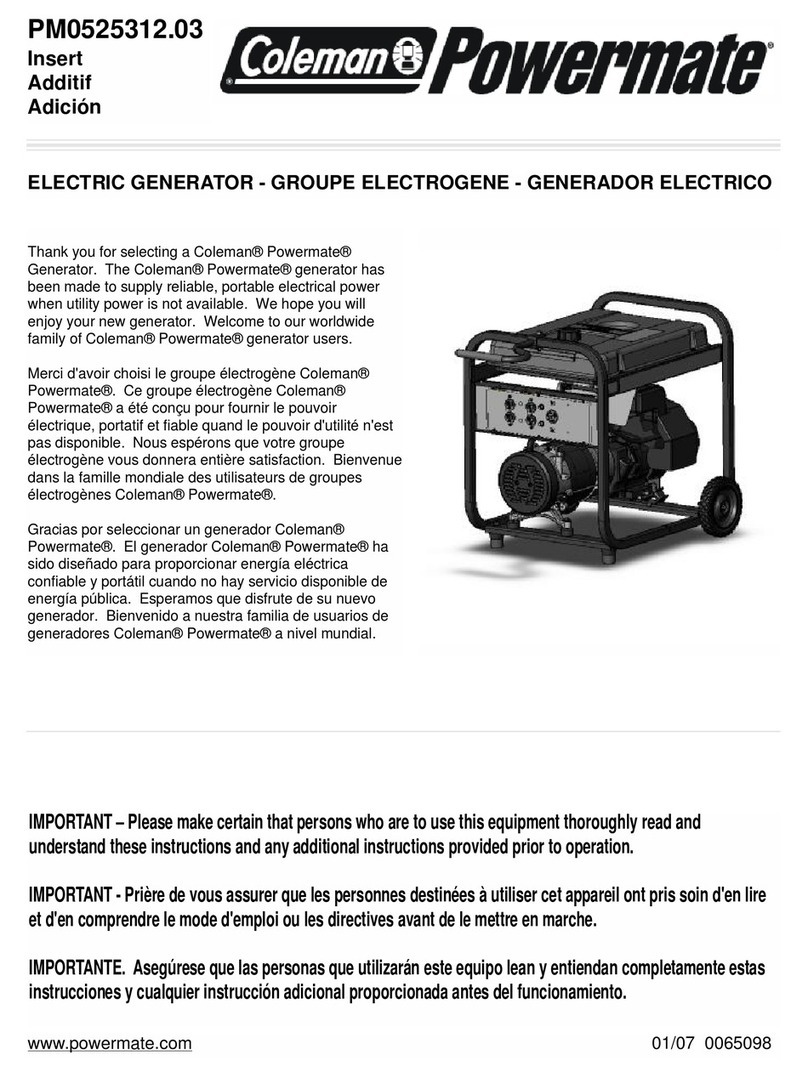
Powermate
Powermate PM0525312.03 user manual
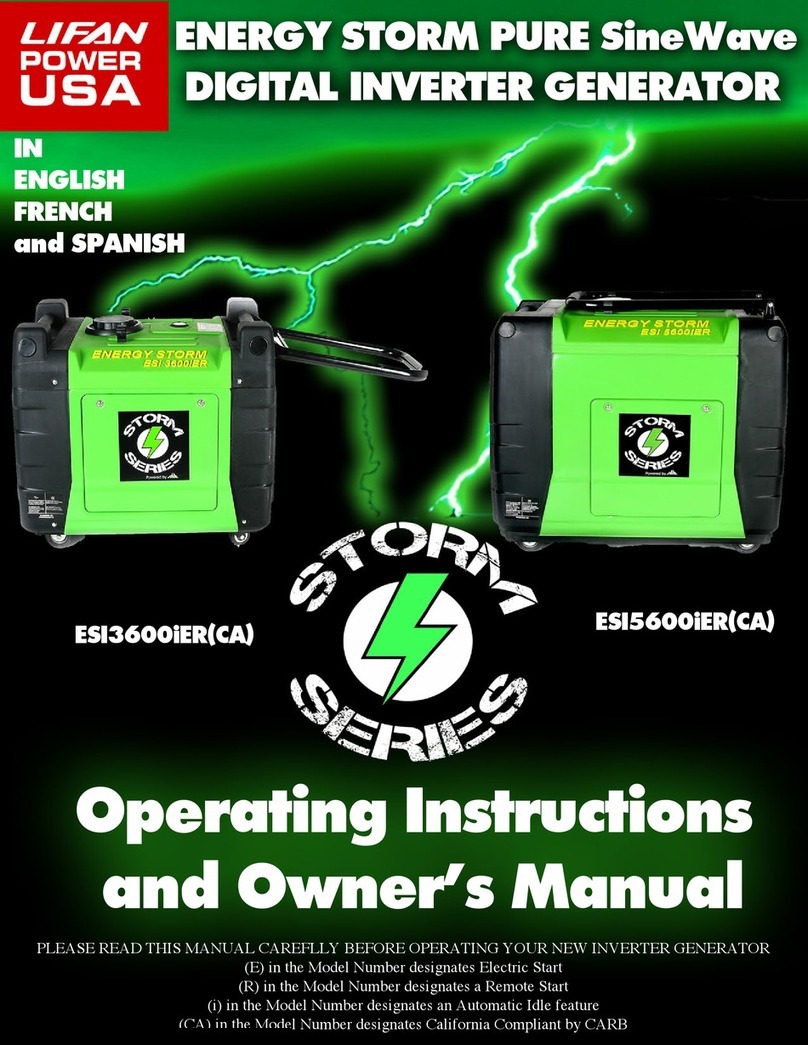
Lifan
Lifan ESI3600iER Operating instructions and owner's manual

Champion Global Power Equipment
Champion Global Power Equipment 201282 quick start
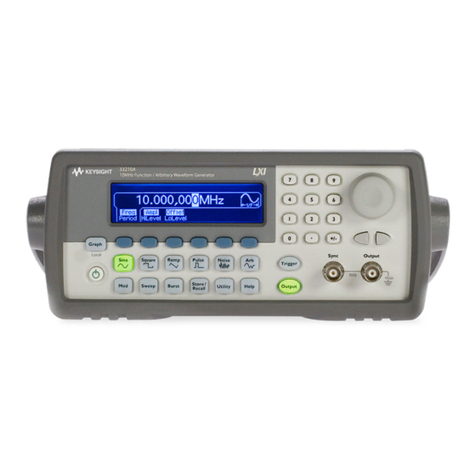
Keysight
Keysight 33210A user guide
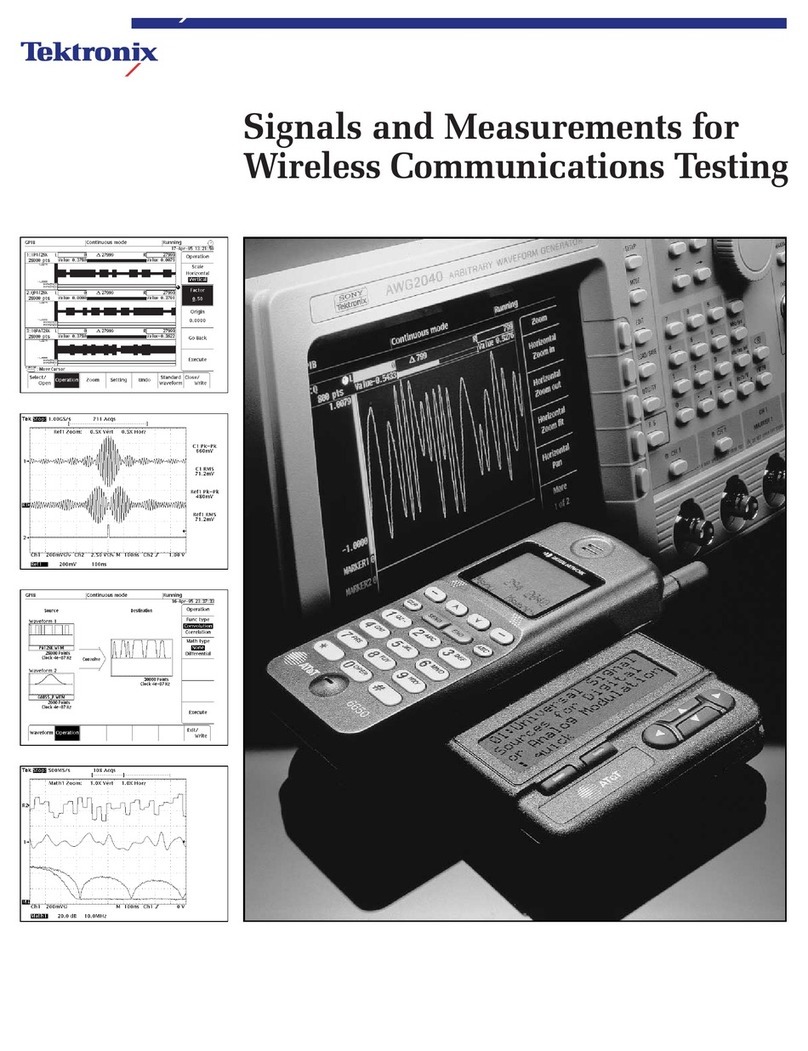
Tektronix
Tektronix AWG 2021 brochure

Generac Power Systems
Generac Power Systems 5500EXL owner's manual

Pacific Scientific
Pacific Scientific Redi-Line DA12A Installation and service manual

Predator
Predator 69677 Owner's manual & safety instructions
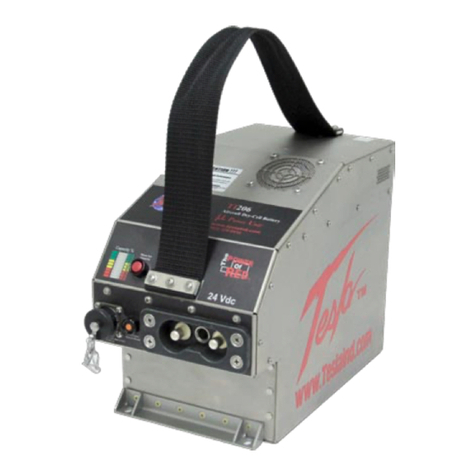
Tesla
Tesla TI206 MPU-24 user manual
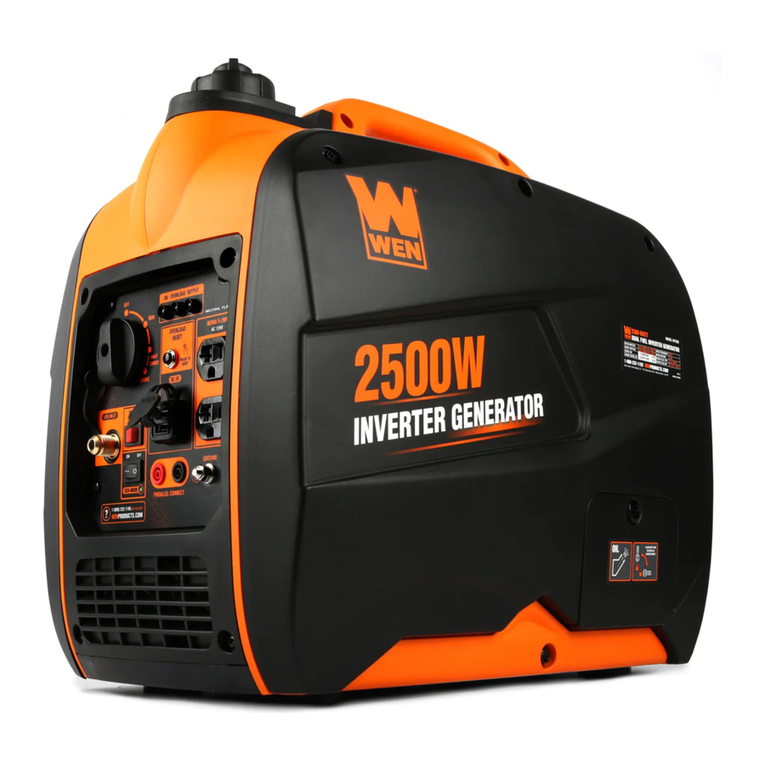
Wen
Wen DF250i user manual

Generac Power Systems
Generac Power Systems CorePower/ES Generator Installation guidelines

GENMAX
GENMAX GM12000E user manual
